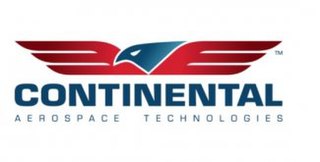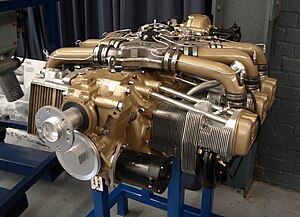
Lycoming Engines is a major American manufacturer of aircraft engines. With a factory in Williamsport, Pennsylvania, Lycoming produces a line of horizontally opposed, air-cooled, four, six and eight-cylinder engines including the only FAA-certified aerobatic and helicopter piston engines on the market.

Continental Aerospace Technologies is an aircraft engine manufacturer located at the Brookley Aeroplex in Mobile, Alabama, United States. It was originally spun off from automobile engine manufacturer Continental Motors Company in 1929 and owned by Teledyne Technologies from 1969 until December 2010. The company is now part of Aviation Industry Corporation of China (AVIC), which is a Government of the People's Republic of China state-owned aerospace company headquartered in Beijing.

The Continental O-300 and the C145 are a family of air-cooled flat-6 aircraft piston engines built by Teledyne Continental Motors.

The Continental O-170 engine is the collective military designation for a family of small aircraft engines, known under the company designation of A50, A65, A75 and A80. The line was designed and built by Continental Motors commencing in the 1940s. It was employed as the powerplant for civil and military light aircraft.

The Cessna 310 is an American four-to-six-seat, low-wing, twin-engine monoplane produced by Cessna between 1954 and 1980. It was the first twin-engine aircraft that Cessna put into production after World War II.

The aircraft diesel engine or aero diesel is a diesel-powered aircraft engine. They were used in airships and tried in aircraft in the late 1920s and 1930s, but never widely adopted beyond this. Their main advantages are their excellent specific fuel consumption, the reduced flammability and somewhat higher density of their fuel, but these have been outweighed by a combination of inherent disadvantages compared to gasoline-fueled or turboprop engines. The ever-rising cost of avgas and doubts about its future availability have spurred a resurgence in aircraft diesel engine production in the early 2010s.

The Bellanca Viking and Super Viking are a series of single-engine, four-seat, high performance, retractable gear aircraft manufactured in the USA during the 1960s and 1970s. The aircraft developed through modifications of classic designs by the aviation pioneer Giuseppe Bellanca. A total of 1,356 Vikings have been produced with most production between 1968 and 1975.

The Ranger V-770 was an American air-cooled inverted V-12 aircraft engine developed by the Ranger Aircraft Engine Division of the Fairchild Engine & Aircraft Corporation in the early 1930s.

The Piper PA-36 Pawnee Brave is a 1970s American single-engined, low-wing, propeller-driven agricultural plane built by Piper Aircraft.

The Robin HR100 is a French four-seat light monoplane, designed by Chris Heintz and built by Avions Pierre Robin as metal-winged version of the Robin DR253 Regent.

The Continental O-520 is a six-cylinder, horizontally opposed aircraft engine produced by Teledyne Continental Motors. First run in 1963 as a development of the IO-346, it has been produced in versions incorporating fuel injection (IO-520), turbo-charging (TSIO-520), and gearing (GTSIO-520).

The Continental IO-550 engine is a large family of fuel injected six-cylinder, horizontally opposed, air-cooled aircraft engines that were developed for use in light aircraft by Teledyne Continental Motors. The first IO-550 was delivered in 1983 and the type remains in production.
Teledyne Turbine Engines (TTE) is a turbine engine manufacturer located in Toledo, Ohio. A division of Teledyne Technologies Inc., TTE is the successor to the former Teledyne CAE.

The Fiat AS.6 was an unusual Italian 24-cylinder, liquid-cooled V configured aircraft racing engine designed and built in the late-1920s by Fiat especially for the Schneider Trophy air races, but development and running problems meant that it was never able to compete. Although the engine suffered from technical problems, it was later used to set a speed record for piston-powered seaplanes that still stands today.
The Zoche aero-diesels are a trio of radical German prototype diesel radial aero-engines intended for light aircraft, designed by Michael and Georg Zoche in the 1990s. Zoche aero-diesels are modular piston engines and are all direct-drive, air-cooled, radial two-stroke diesels with up to four cylinders per row. They all feature direct fuel-injection, two-stage charging, and intercooling. In each plane, all the pistons connect to a single throw on the crankshaft.

The Trident TR-1 Trigull is a Canadian amphibious aircraft that was developed by Trident Aircraft of Burnaby, British Columbia and later Sidney, British Columbia. The aircraft was intended to be supplied as a complete ready-to-fly certified aircraft. The company encountered financial difficulties and only three prototypes were ever built.
The Franklin O-425 was an American air-cooled aircraft engine that first ran in the mid-1940s. The engine was of six-cylinder, horizontally-opposed layout and displaced 425 cu in (7 L). The power output was between 240 hp (179 kW) and 285 hp (213 kW) depending on variant. The O-405-13 (6V6-300-D16FT) of 1955 was a vertically mounted, turbocharged and fan cooled version for helicopters.
The Franklin O-405 was an American air-cooled aircraft engine of the 1940s. The engine was of six-cylinder, horizontally-opposed layout and displaced 405 cu in (6.64 L). The power output was between 200 hp (149 kW) and 250 hp (186 kW) depending on variant. The O-405-9 (6ACV-403) was a vertically mounted, fan cooled version for helicopters.
The Franklin O-300 was an American air-cooled aircraft engine of the early 1940s. The engine was of six-cylinder, horizontally-opposed layout and displaced 300 cu in (5 L). The power output ranged between 130 hp (97 kW) and 175 hp (130 kW) depending on variant. The 6ACG-298 featured a geared propeller drive.

The Continental O-526 is a family of air-cooled flat-6 aircraft piston engines built by Teledyne Continental Motors.















